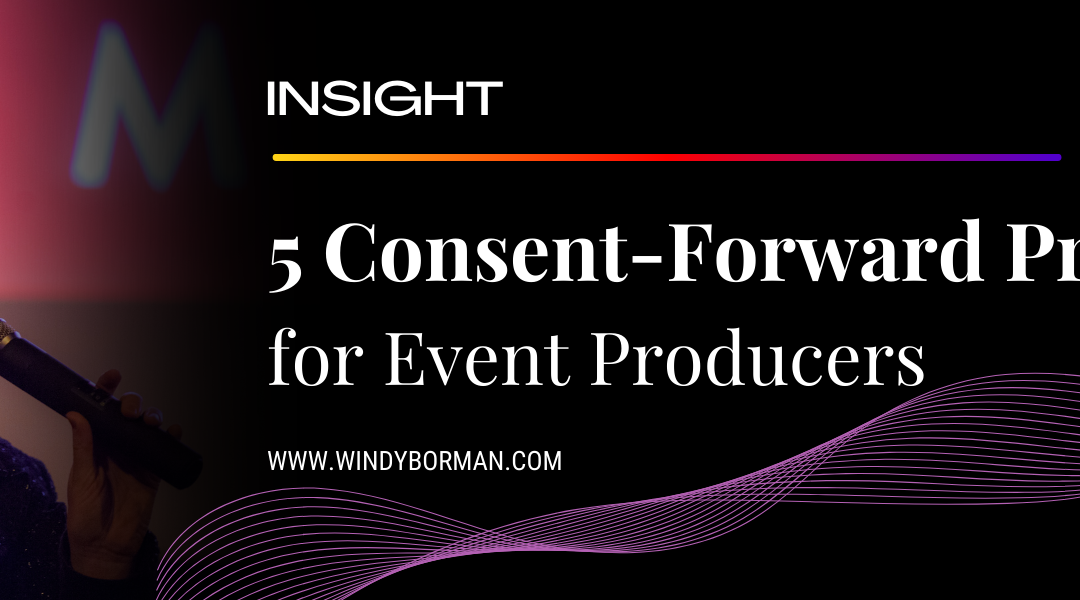Professional event producers must prioritize safety and minimize harm to ensure successful and ethical events. This article explores five consent-focused strategies to enhance safety and reduce harm, with the goal of elevating your event production standards.
Take-Aways:
- Decide to value Consent-Forward practices during Development if you want them to seep into all processes across all departments.
- The saying “The Show Must Go On” prioritizes urgency over safety. Instead, I recommend we “Move at the speed of safety.”
- Instead of viewing boundaries as obstacles, adopt a growth mindset and view them as opportunities to build trust.
- Part of respecting people’s boundaries is anticipating how to react when boundaries are crossed. Look for the signs.
- Active Shooter Training is essential, but how often do we train event teams about Bystander Intervention?
Value Consent-Forward Practices from the Beginning
The first strategy is to decide that you want to prioritize safety and consent in your event production. All other consent-forward practices will stem from this decision. Ideally, this should happen during the Development stage. However, you can introduce consent-focused practices into your team’s workflows and procedures, even if you are hired during the Pre-Production or Production phase. Remember, all departments may not adopt these practices unless endorsed from the top down, so adjust your expectations accordingly.
Move at the Speed of Safety
Second, we need a reckoning about the dangers of the saying, “The Show Must Go On.” This motto prioritizes capitalism over safety. It creates urgency and puts performers and crew in dangerous situations if they cannot stop the performance due to safety concerns.
Instead, I recommend we “Move at the Speed of Safety”. I introduce this motto when I “Paper Tech”, also known as the walk-through of a Show Flow or a Technical Run of Show before we rehearse live. I reinforce the motto throughout rehearsals, performances, and include it as part of my sign-off by saying, “Thank you, Everyone. Let’s strike safely” before I hand over my headset and we break down the performance space.
Hear and Respect Boundaries
My third strategy for event producers is to get comfortable setting and hearing boundaries. Instead of viewing boundaries as obstacles, I adopt a growth mindset and view them as opportunities to build trust with performers, speakers, and crew.
Performers and Speakers:
Whether I’m working with live performers or corporate executives, I ask them if they have any questions, concerns, or sensitivities. This opens the door for us to discuss everything from the best way to get on stage (perhaps a ramp or offering a hand as they walk off stage into the dark will help) to what to wear for easy microphone placement (include a belt, waistband, or jacket pocket). It also helps me think through potential incidents, such as when I recently hired Cirque performers for a corporate after-party. After discussing their acts, we encircled their performance areas around the room with velvet stanchions to highlight their performances and avoid crashing into caterers or guests.
Crew Members:
If we don’t have time for a complete Boundary Check-In each day, I find time to say, “You can always set a boundary with me.” I’ve been working as a Consent-Forward Artist for years, and I’m still amazed at how much people’s shoulders relax when I tell them that saying No is an option.
Conflict De-Escalation:
Normalizing boundaries is also helpful in de-escalating conflicts. When someone exhibits a stress response, I say, “I hear and respect your boundaries.” I let them take a few deep breaths to get back into their body, and then I ask, “Are you ready to talk about solutions? Or do you need more time?”
These phrases validate their boundaries and invite them to co-create solutions to the conflict or obstacle when ready.
Look for the Signs
My fourth strategy involves looking for warning signs and safety gestures so that you know when and how to react if a boundary is crossed.
Safety Gesture:
Part of respecting people’s boundaries is anticipating how to react when boundaries are crossed. With performers (or VIPs with security details), I ask if they have a safety word or gesture they use to signal a boundary cross or potential threat. If they don’t have one, we co-create one, and then I share it with the rest of the crew, including security, so we know what to look for.
In the case of the Cirque performers, the gesture was a “shake it off” gesture from a Taylor Swift video. But it can be anything. Whatever you choose, keep it simple and something out of character or outside their routine choreography so you don’t accidentally rush the stage when everything is fine.
Stress Responses:
With other corporate executives, clients, and crew, we don’t always have a safety gesture. Instead, I rely on my emotional intelligence and look for behaviors corresponding to the four (4) stress responses: Fight, Flight, Freeze, and Fawn. If I see the behavioral responses to stress, I ask to check in with the person one-on-one. “An ounce of prevention is worth a pound of cure.” Checking in can avoid a public outburst, communication meltdown, and even a mental health crisis.
Self-Care:
Part of having a consent-forward practice also means being aware of my boundaries and stress responses. I rely on my Self-Care Toolkit to get me through stressful events, and I’ve learned to schedule a massage a few days after the event to rejuvenate me before the next one.
Bystander Intervention
“Bystander Intervention is recognizing a potentially harmful situation or interaction and choosing to respond in a way that could positively influence the outcome.” – Right To Be
During my contracts as an event producer, I have witnessed and experienced behavior that required bystander intervention. [Read my experience.]
I understand when people are under stress, they are not their best selves. However, Bystander Intervention teaches us that when we witness harassment, abuse, or harm in the workplace, we have five choices:
- Distract
- Delay
- Document
- Delegate
- Direct communication
[Learn “The 5 D’s” of Bystander Intervention].
Active Shooter Training is important, but how often do we train event crews about Bystander Intervention?
I receive Active Shooter training annually for insurance reasons, but I’ve had to seek my own professional development on Bystander Intervention. I’d like to see this change with employers offering Bystander Intervention training for all event crew and speakers.
Conclusion
By increasing safety and minimizing harm at events, we set a new benchmark for excellence. As event producers, ensuring attendee and crew safety creates exceptional experiences, trust, and respect. Let’s prioritize safety in events, setting a standard for others to follow.


